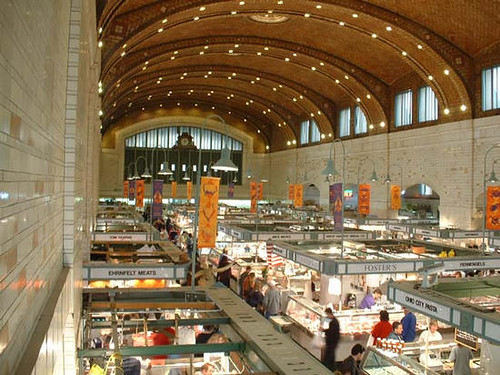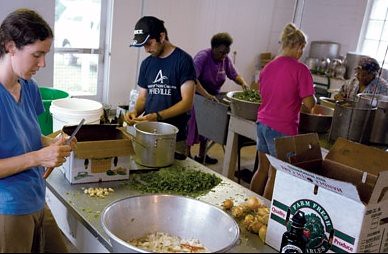The uncreative city #1: food policy

West Side Market, Cleveland. Photo from West Side Market.
I wrote a few weeks ago about having a food security and foodways set of policies for the city rather than narrow-mindedly focusing solely upon "grocery stores" as has Councilmember Cheh for dealing with "food deserts." See "Do we need a grocery ambassador or a city-wide food security/foodways plan?"
Sure, I am concerned about food deserts, but one problem is how food deserts are measured and in DC, where 2/3 of the city borders Montgomery and Prince George's Counties in Maryland, many groceries stores are located just across the border in Maryland, and it is crazy to not consider these stores--all located within the typical 3 mile retail trade area of a supermarket--as serving DC residents.
Today I came across what look to be two new incredible resources on community food systems, the new Journal of Agriculture, Food Systems, and Community Development and the companion website, AgDEV Online, a Community of Practice Website. They are subscription products and likely well worth the combined price of $56-$73/annually. Right now, the inaugural issue of the journal is open access through October 1st.
This reminds me of something I have been meaning to write for awhile, a follow up to the previous entry, with regard to the idea of spurring innovation and community revitalization through urban food and food security policies.
The above-mentioned legislation by Councilmember Cheh focuses on attracting supermarkets to the city. What about trying to create an East of the River Public Market?
Like Eastern Market or the DC Farmers Market, or great public markets such as the Reading Terminal Market in Philadelphia or the West Side Market in Cleveland--both are far more fabulous than the public markets that remain in DC and would be better models.
Articles that I clipped to mention in this context include these pieces from the travel sections of the New York Times, "Seattle's New Food Market" about the development of the Melrose Market in the Capital Hill neighborhood, and "A Fresh Face in South London" about the revitalization of the Brixton Market in South London.
And in two weeks, on September 10th, my friends-colleagues at Neighbors in the Strip in Pittsburgh are opening their version, the of a Pittsburgh Public Market, to provide the ability for farmers and smaller businesses to sell in the Strip District food district, in spaces smaller than those that are available on Penn Avenue, where most of the prime spots are not available anyway.

Facebook photo by Prasad of the Spice grocery store under construction at the Pittsburgh Public Market.
And last October, a permanent food store, called the Downtown Phoenix Public Market, but not a public market in the traditional sense, selling products from local vendors, opened adjacent to the site of the Farmers Market in Downtown Phoenix, providing a grocery store for area residents open 7 days/week. (Suzanne and I happened to be there for the weekend soft opening.)
The Melrose Market is privately owned, just like the Belvedere Square Market in North Baltimore. Both are upscale. But nothing says that a privately owned public market has to be upscale and expensive.
There are other examples of the creation of new markets as a community revitalization initiative, such as the Midtown Global Exchange Market in Minneapolis, in a public/nonprofit-private partnership.
What prevents DC from being equally creative?, from using the framework of a public market in Anacostia to accomplish multiple objectives:
- food access;
- places for farmers and food producers in the region to sell their products;
- economic revitalization and business development in an area of the city where poverty persists;
- health promotion -- you could incorporate my idea of a teaching and demonstration kitchen for wellness and health education, and you could even have a WIC-approved products store;
- business development -- a place to locate new businesses by DC residents including;
- a commercial grade "community kitchen" to support business development initiatives comparable to similar food and catering business incubators elsewhere such as the La Cocina in San Francisco and Mi Kitchen es su Kitchen in Brooklyn.
- although a community kitchen can also support group food initiatives, not just commercial activity. For example, rural Virginia is known for community canneries, where local gardeners have access to commercial quality kitchen equipment and technical assistance to can or freeze home-grown produce. See "Community canneries" from American Profile.
- a meals preparation "store" where people can come together and make multiple meals for their families in bulk;
- maybe the University of Maryland could even set up a satellite ice cream bar;
etc.

Teaching kitchen, River Market, Little Rock, Arkansas. Photo courtesy of Daman Hammond.

Community canning. Lee O'Neill and others process vegetables at the Keezletown (Va.) Community Cannery, which has supported food preservation since 1942. Image by Doug Miller from American Profile Magazine.
What creates DC from being equally creative is pretty simple. Lack of vision. Lack of creativity. A failure to get out and go beyond the borders of the city and shake things up and think about things in new and different ways. And a failure to think about policies that are integrative and achieve multiple objectives simultaneously rather than one thing only.
Labels: change-innovation-transformation, commercial district revitalization, food-agriculture-markets, retail enterpreneurship development



0 Comments:
Post a Comment
<< Home